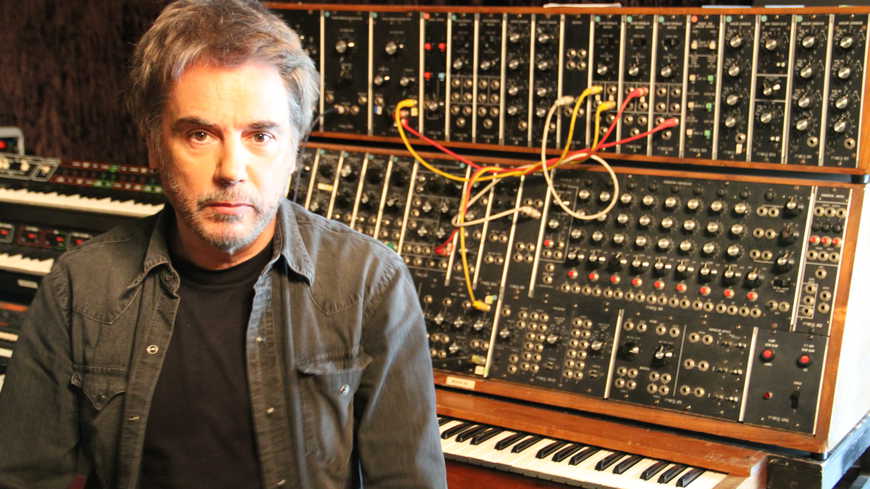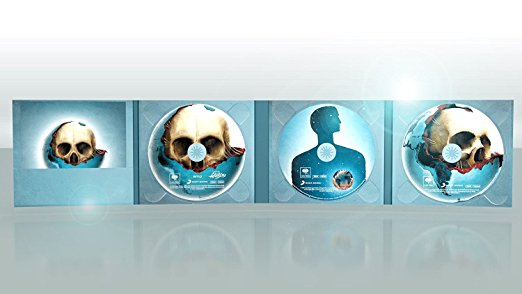Written by John Diliberto on April 3, 2017
 It’s pretty rare that an artist could take three albums spanning 40 years, put them together, and have them sound like a coherent whole, as if it was the plan all along for them to sit together as a single epic work. But French electronic artist Jean-Michel Jarre has done that with his Oxygene Trilogy which includes the original recordings of Oxygene from 1976, Oxygene 7-13 (effectively Oxygene 2), in 1997 and now the brand new Oxygene 3 in 2016. Back when Oxygene 7-13 came out I wrote that “Jarre looked back to his signature work, but instead of re-working the themes, he approached it as if he had finished Oxygene 1-6 and then walked in the studio the next day in 1976, rather than two decades later.”
It’s pretty rare that an artist could take three albums spanning 40 years, put them together, and have them sound like a coherent whole, as if it was the plan all along for them to sit together as a single epic work. But French electronic artist Jean-Michel Jarre has done that with his Oxygene Trilogy which includes the original recordings of Oxygene from 1976, Oxygene 7-13 (effectively Oxygene 2), in 1997 and now the brand new Oxygene 3 in 2016. Back when Oxygene 7-13 came out I wrote that “Jarre looked back to his signature work, but instead of re-working the themes, he approached it as if he had finished Oxygene 1-6 and then walked in the studio the next day in 1976, rather than two decades later.”
Back in 1997, Jarre did indeed dust off his classic analog synthesizers like the ARP 2600, VCS3, Mellotron and Theremin and continued on his epic journey. He’s done a bit of the same with Oxygene 3, picking up the circuits, sequences and modes of his earlier work, but there is a more precise, contemporary sound as Jarre also used all the modern technology at his disposal.
Born in 1948 in Lyon, he’s the son of acclaimed film composer Maurice Jarre. His parents separated when Jean-Michel was young and he claims he didn’t have much contact with his father growing up, but the cinematic gene was clearly passed down. His early music influences came from visits to a Parisian jazz club run by his mother. He literally sat on the knees of new jazz expressionists like Don Cherry and Archie Shepp and when he was 10, Chet Baker played “Happy Birthday” to him on trumpet.
Although Jarre spent some time as a jazz pianist, I can’t say that influence shows, but it did instill in him a sense of musical adventure which was satisfied by electronic music. He worked with French musique concrète pioneer, Pierre Schaeffer in 1968. In the 1940s, Schaeffer, using phonograph records and then tape, created compositions out of sounds from the world. Theoretically one of the first “scratch DJs”, his influence would echo later in Jean-Michel Jarre’s music.
 The original Oxygene became a landmark release in 1976. There had already been many artists who had explored sequencer driven analog synthesizer music. Klaus Schulze had released Picture Music, Timewind and Moondawn by 1976. Tangerine Dream had Phaedra, Rubycon and Ricochet out and let’s not forget Tonto’s Expanding Headband predating them all in 1971.
The original Oxygene became a landmark release in 1976. There had already been many artists who had explored sequencer driven analog synthesizer music. Klaus Schulze had released Picture Music, Timewind and Moondawn by 1976. Tangerine Dream had Phaedra, Rubycon and Ricochet out and let’s not forget Tonto’s Expanding Headband predating them all in 1971.
Nevertheless, Jarre made this sound his own, distinctively, making his pulsing rubber-band rhythms melodic. His main melody on “Oxygene Pt.4”, derived from Gershon Kingsley’s 1969 synth hit, “Popcorn,” made me think Oxygene was a little kitsch at the time, especially when compared to TDream’s and Schulze’s deeper, more abstract sounds. But I’ve come to forgive that over the years. It was those melodies that brought millions to this hitherto esoteric sound. And what was once kitsch, now sounds as fresh today as when Jarre sculpted them on just 8 tracks and a hand-full of cranky analog synthesizers.
On Oxygene 7-13, even using the same gear in ’97 as he used in ‘76, the results were similar although the sound was thicker and often more driving. With Oxygene 3, Jarre remains in the same mode, but uses updated equipment and recording techniques. In addition, after Electronica 1 and 2, his two albums of collaborations with musicians two to three generations younger than him, there are certain contemporary elements that have crept in. There’s a touch of EDM’s distressed sonics, the staccato riffing at the end of “Pt.14” and the bass drop on “Part 19” that wouldn’t have been there in 1976.
 On the other hand, the fat bassline that opens “Pt.17” is pure Jarre, as is the rest of the track with a phase-shifted electronic string ensemble, wah-wah melody and electronic percussion just a step above your home organ from 1976 courtesy of the Korg Minipop. Of course, those sounds are completely back in style now.
On the other hand, the fat bassline that opens “Pt.17” is pure Jarre, as is the rest of the track with a phase-shifted electronic string ensemble, wah-wah melody and electronic percussion just a step above your home organ from 1976 courtesy of the Korg Minipop. Of course, those sounds are completely back in style now.
The Oxygene Trilogy is a sweeping listening experience as Jarre carries you through rhythmic drives, free floating ambiences and especially in the earlier movements, vortexes of sonic exploration that are beatless and melody free. All the elements of the original are in Oxygene 3, sometimes obliquely referenced, sometimes directly. “Oxygene Pt.6,” the close of the original album, emerges, hidden in the distance behind a haze of white noise winds on “Pt.20.”
Bands like Survive and soundtracks to TV shows like Stranger Things owe a direct debt to Jean-Michel Jarre. It’s a sound that harkens back to another time, but is timeless. And you can hear it on the 40 years of music development represented on Jean-Michel Jarre’s Oxygene Trilogy .
Join the Echoes CD of the Month Club Now
Get the Oxygene Trilogy and George Winston’s Spring Carousel and TWO MONTHS FREE MONTHS.
Jean-Michel Jarre will be touring America in late spring. Read about it here.
Hear Jarre talk about Oxygene Trilogy in Echoes Podcast.
Hear Jarre talk about Electronica 1 in Echoes Podcast
Read review of Jean-Michel Jarre’s Electronica 2: The Heart of Noise
